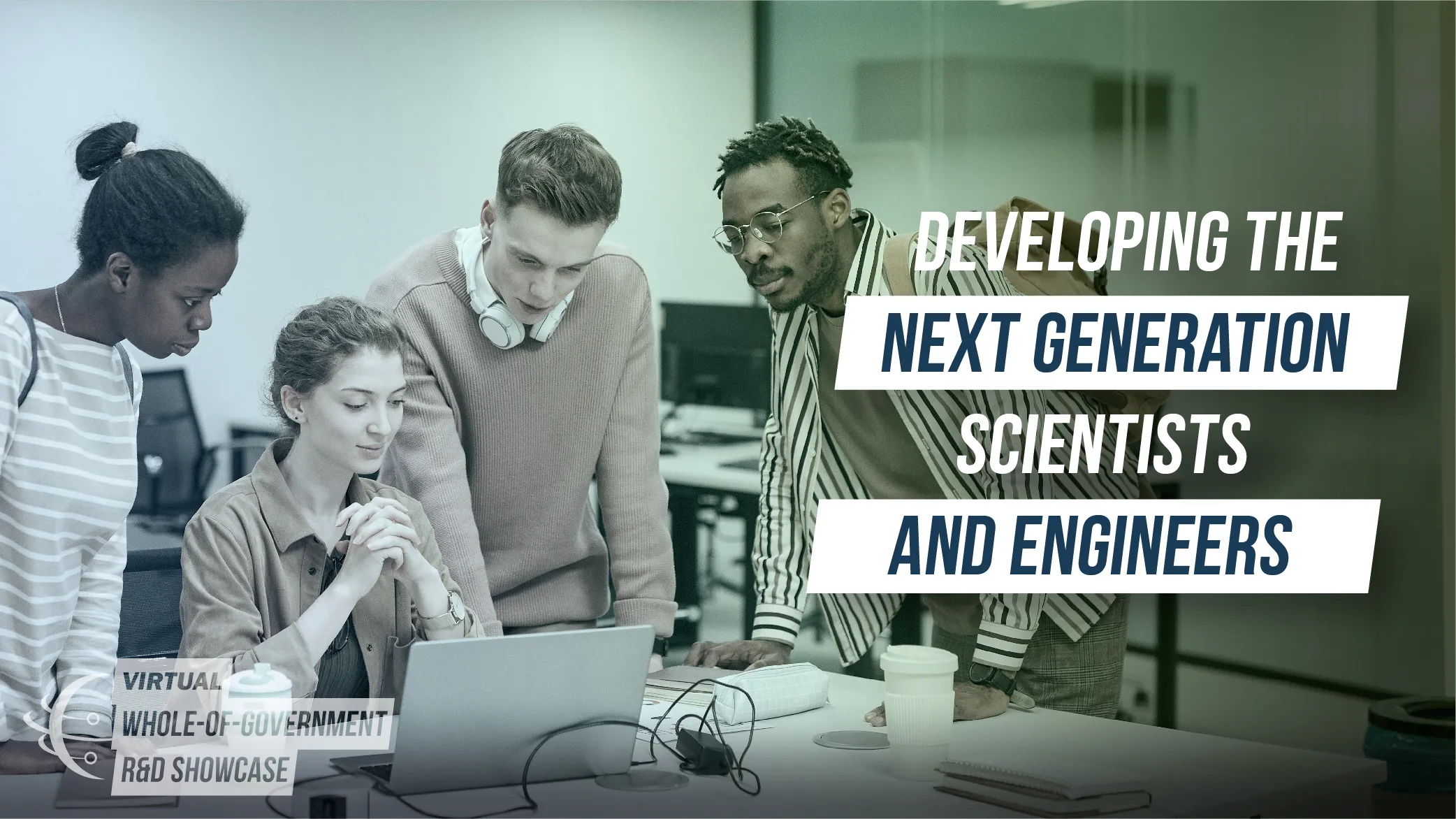 Welcome to Series 4: Building Whole-of-Government R&D Partnerships—the final installment of the Department of Homeland Security (DHS) Science and Technology Directorate’s (S&T) Virtual Whole-of-Government Research and Development (R&D) Showcase—where the best minds in research, science, and innovation are coming together to secure our future now.
Welcome to Series 4: Building Whole-of-Government R&D Partnerships—the final installment of the Department of Homeland Security (DHS) Science and Technology Directorate’s (S&T) Virtual Whole-of-Government Research and Development (R&D) Showcase—where the best minds in research, science, and innovation are coming together to secure our future now.
The demands on DHS are great. U.S. government research organizations share common goals of advancing research and mobilizing innovation to save lives and secure our future. This series will highlight how our whole-of-government approach to unifying research is working for the American public by staying ahead of threats and achieving greater public-private collaboration and inclusiveness with industry, startups, academia, and DHS National Labs. To develop the workforce of the future and enhance U.S. competitiveness around the world, it is vital for S&T to ensure Americans of all backgrounds are drawn into the creation and the rewards of research and science. Learn how government officials working in procurement, acquisition, and technology transfer are thinking differently about the future of cross-disciplinary research and the technology marketplace.
This final series highlights how S&T is accelerating technology development and enhancing security to keep our nation moving forward. Advances in science continue to shape who we are today and where we are going—a nation prepared for new opportunities and complex 21st Century challenges.
 Expert Panel 1: Enhancing Technology Transfer and Commercialization Through Interagency Partnerships—S&T applies scientific, engineering, and analytic innovations to advance mission-critical technologies and methods. End users of these technologies are often members of the broader homeland security community. For example, local firefighters and law enforcement will use Next Generation 911 systems, machine learning capabilities and advances in autonomy. S&T works with user communities to understand their needs and limitations, identify, evaluate, and invest in promising technologies, and share the results through a variety of mechanisms. As the designated DHS Office of Research and Technology Applications, S&T’s Technology Transfer and Commercialization Program manages technology transfer and commercialization activities for the department, including DHS components and laboratory network. Discover how S&T is bringing new capabilities out of the labs and into communities.
Expert Panel 1: Enhancing Technology Transfer and Commercialization Through Interagency Partnerships—S&T applies scientific, engineering, and analytic innovations to advance mission-critical technologies and methods. End users of these technologies are often members of the broader homeland security community. For example, local firefighters and law enforcement will use Next Generation 911 systems, machine learning capabilities and advances in autonomy. S&T works with user communities to understand their needs and limitations, identify, evaluate, and invest in promising technologies, and share the results through a variety of mechanisms. As the designated DHS Office of Research and Technology Applications, S&T’s Technology Transfer and Commercialization Program manages technology transfer and commercialization activities for the department, including DHS components and laboratory network. Discover how S&T is bringing new capabilities out of the labs and into communities.
 Expert Panel 2: Developing the Next Generation Scientists and Engineers—S&T is looking closely at how its research and technology development mission will change over the next 20 years. Knowing what skills will be needed and where these skills are located requires new thinking and ways of doing business. It also requires diverse backgrounds, experiences, and knowledge of our evolving security landscape. As technology provides new opportunities for more people to innovate and make a difference in the world, S&T’s Office of University Programs Minority Serving Institutions portfolio is building a pipeline of dedicated students and faculty from all parts of society who are qualified and ready to begin careers in homeland security fields. Learn how S&T is developing the next generation of scientists and engineers and what role you can play to expand partnerships, opportunities, and capabilities.
Expert Panel 2: Developing the Next Generation Scientists and Engineers—S&T is looking closely at how its research and technology development mission will change over the next 20 years. Knowing what skills will be needed and where these skills are located requires new thinking and ways of doing business. It also requires diverse backgrounds, experiences, and knowledge of our evolving security landscape. As technology provides new opportunities for more people to innovate and make a difference in the world, S&T’s Office of University Programs Minority Serving Institutions portfolio is building a pipeline of dedicated students and faculty from all parts of society who are qualified and ready to begin careers in homeland security fields. Learn how S&T is developing the next generation of scientists and engineers and what role you can play to expand partnerships, opportunities, and capabilities.
 Expert Panel 3: Saving Lives by Moving Science and Technology to the Frontlines—To protect our way of life and stay ahead of future threats, DHS operational components and the broader homeland security enterprise must enhance preparedness and better understand emerging threats, which could impact our safety and security. To reduce risks, S&T has built a world-class laboratory system of research partners and an extensive body of knowledge to keep frontline security operators informed, equipped, and ready to do their jobs. This discussion highlights how strategic investments in DHS laboratory research and science are providing invaluable tools of decision-making, risk analysis, and threat characterization and detection in areas like transportation screening, chemical and biological threat mitigation, and first responder technologies. We need science to help us address unknowns. The country relies on S&T’s labs to do the science and turn research into action to keep us safe and secure.
Expert Panel 3: Saving Lives by Moving Science and Technology to the Frontlines—To protect our way of life and stay ahead of future threats, DHS operational components and the broader homeland security enterprise must enhance preparedness and better understand emerging threats, which could impact our safety and security. To reduce risks, S&T has built a world-class laboratory system of research partners and an extensive body of knowledge to keep frontline security operators informed, equipped, and ready to do their jobs. This discussion highlights how strategic investments in DHS laboratory research and science are providing invaluable tools of decision-making, risk analysis, and threat characterization and detection in areas like transportation screening, chemical and biological threat mitigation, and first responder technologies. We need science to help us address unknowns. The country relies on S&T’s labs to do the science and turn research into action to keep us safe and secure.
 Expert Panel 4: Advancing Safety and Security Through International R&D Cooperation—Emerging threats magnified by COVID-19, climate change, cyber hackings, and violent extremism, are stark reminders of how connected we all are—and how the problems of one country can rapidly spill over borders, and ultimately affect the entire world. To keep pace with future threats and uncertainties, S&T is strengthening international partnerships and creating new opportunities for collaborative research to enhance public health security, climate resilience, aviation security, and first responder capabilities. This discussion will highlight the value of scientific cooperation between S&T and its partners in the 5 Research and Development (5RD) Council: Canada, United Kingdom, Australia, and New Zealand. Learn how these partnerships provide the department with more capabilities to enhance security and advance the Administration’s priority of engaging with the international community to use science, research, and development to address our shared challenges.
Expert Panel 4: Advancing Safety and Security Through International R&D Cooperation—Emerging threats magnified by COVID-19, climate change, cyber hackings, and violent extremism, are stark reminders of how connected we all are—and how the problems of one country can rapidly spill over borders, and ultimately affect the entire world. To keep pace with future threats and uncertainties, S&T is strengthening international partnerships and creating new opportunities for collaborative research to enhance public health security, climate resilience, aviation security, and first responder capabilities. This discussion will highlight the value of scientific cooperation between S&T and its partners in the 5 Research and Development (5RD) Council: Canada, United Kingdom, Australia, and New Zealand. Learn how these partnerships provide the department with more capabilities to enhance security and advance the Administration’s priority of engaging with the international community to use science, research, and development to address our shared challenges.
 EBook
EBook
This companion document offers a glimpse of the exciting efforts discussed in our expert panel discussions. View the downloadable PDF to learn about important S&T efforts around building our future R&D workforce, transferring technologies out of laboratories and into communities, enhancing international collaboration to address global threats, and more.
 Related Stories
Related Stories
The resources listed offer additional information on various S&T research efforts related to building our future R&D workforce, transferring technologies out of laboratories and into communities, enhancing international collaboration to address global threats, and more.
 4.1 Enhancing Technology Transfer and Commercialization Through Interagency Partnerships
4.1 Enhancing Technology Transfer and Commercialization Through Interagency Partnerships
- John Rein, Commercialization Accelerator Program Manager, Department of Homeland Security Science and Technology Directorate
- Mike D’Onofrio, Technology Transfer and Transitions Specialist, U.S. Army Combat Capabilities Development Command, Army Research Laboratory
- Jonathan Spielman, Program Manager, Office of Research and Technology Applications, Federal Bureau of Investigation
- Kalpana Reddy, Attorney Advisor for Office of Industry Partnerships, Department of Homeland Security Science and Technology Directorate
4.2 Developing the Next Generation Scientists and Engineers
- Rhonda Binda, Deputy Borough President, Queens, New York City
- Angelyn Spaulding Flowers, J.D. Ph.D., Professor, Crime, Justice, and Security Studies Program, Division of Social and Behavioral Sciences at the University of the District of Columbia
- Garfield Jones, D. Engr., Associate Chief, Strategic Technology Office, Cybersecurity and Infrastructure Security Agency
- Robert Newman, Maj. Gen., (Ret.), Director, Office of Engagement and Partnerships, Department of Homeland Security Science and Technology Directorate
- Greg Simmons, Program Manager, Office of University Programs, Department of Homeland Security Science and Technology Directorate
4.3 Saving Lives by Moving Research and Science to the Frontlines
- Helen Mearns, Deputy Director, Chemical Security Analysis Center, Department of Homeland Security Science and Technology Directorate
- Alice Hong Keuhn, Director, National Urban Security Technology Laboratory, Department of Homeland Security Science and Technology Directorate
- Dr. Christopher Smith, Director, Transportation Security Laboratory, Department of Homeland Security Science and Technology Directorate
- Julie Brewer, Senior Official Performing the Duties of the Chief of Staff, Department of Homeland Security Science and Technology Directorate
4.4 Advancing Safety and Security Through International R&D Cooperation
- Robert Burns, Executive Director, Office of Innovation and Collaboration, Department of Homeland Security Science and Technology Directorate
- Mark Williamson, Director General, Policy and Advice, Defence Research and Development Canada
- Henry Hirsch, Deputy Director, CBRNE Science and Technology, Homeland Security Group, United Kingdom Home Office
- Nigel McGinty, Ph.D., Acting Chief Technology Officer in the Strategy and National Security, Science Engagement and Impact Division, Defence Science and Technology Group, Australia
- Simon Rae, Manager, International Science Partnerships at Ministry of Business, Innovation and Employment, New Zealand
